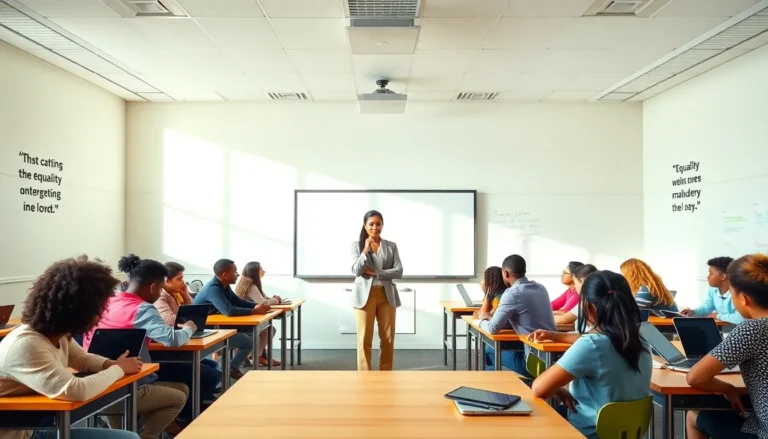In the ever-evolving landscape of education, AI teaching assistants are stepping into the spotlight like the rock stars they were born to be. Imagine a classroom where students get instant feedback on their questions, and teachers have more time to focus on inspiring young minds instead of drowning in paperwork. Sounds like a dream, right? Well, it’s becoming a reality.
Table of Contents
ToggleOverview of AI Teaching Assistants
AI teaching assistants play a transformative role in modern education. These digital tools offer immediate feedback, enabling students to understand concepts better and improve their performance. Teachers benefit from reduced administrative tasks, allowing them to focus more on personalized instruction.
Educational institutions increasingly integrate AI teaching assistants to enhance learning environments. Features of these assistants include answering student queries, grading assignments, and providing tailored resources. Schools utilizing AI report higher engagement and improved academic outcomes.
Customization stands out as a key advantage of AI teaching assistants. They adapt to individual learning styles, ensuring that each student receives support suited to their needs. This adaptability fosters a more inclusive educational experience.
Data-driven insights enhance the functionality of AI teaching assistants. By analyzing performance metrics, they identify areas where students struggle and suggest targeted interventions. This proactive approach helps educators make informed decisions regarding curriculum adjustments.
Collaboration between AI teaching assistants and human educators strengthens the learning framework. While AI handles routine tasks, teachers can concentrate on mentoring and fostering creativity in their students. This partnership promotes a balanced educational atmosphere.
As technology evolves, the scope of AI teaching assistants continues to expand. New capabilities, such as speech recognition and natural language processing, improve their interaction quality. This evolution enhances the support students receive, ultimately shaping a more effective learning journey.
Benefits of AI Teaching Assistants
AI teaching assistants offer numerous benefits that enhance the educational landscape. Their integration into classrooms transforms traditional teaching methods, providing innovative solutions for both students and educators.
Personalized Learning Experience
Personalized learning thrives with AI teaching assistants. These digital tools adapt to each student’s unique learning style, tailoring lessons and resources accordingly. By assessing individual performance metrics, AI can suggest customized interventions. Educators gain insights into student progress, enabling them to focus on specific areas needing improvement. Engagement increases when learning aligns with personal interests and strengths. This approach fosters inclusivity, ensuring every student has the opportunity to thrive academically. Teachers benefit from having a resource that complements their teaching strategies, which ultimately enriches the educational experience.
Availability and Accessibility
AI teaching assistants enhance availability and accessibility in education. They provide 24/7 support, allowing students to seek help whenever it’s convenient for them. Immediate feedback on assignments and queries aids in maintaining motivation outside traditional school hours. Accessibility is improved for students with disabilities, as AI tools can cater to various learning needs and preferences. By offering diverse resources, such as text-to-speech options and visual aids, they create a more equitable learning environment. The continuous nature of this support makes learning more flexible, accommodating busy schedules and unique challenges.
Challenges in Implementing AI Teaching Assistants
Implementing AI teaching assistants presents various challenges. These obstacles must be addressed to maximize their benefits in education.
Data Privacy Concerns
Data privacy concerns arise when using AI teaching assistants. Sensitive student information can be at risk if proper safeguards aren’t implemented. Educational institutions often face stringent regulations governing data protection, such as FERPA. Compliance with these laws becomes crucial to maintaining trust between students and educational organizations. In addition, parents might worry about how their children’s data is used. Ensuring transparency in data collection and usage helps alleviate these concerns. Organizations must prioritize developing secure systems that protect user data while leveraging AI insights to enhance learning.
Resistance from Educators
Resistance from educators frequently emerges when integrating AI teaching assistants. Some educators might feel threatened by the introduction of technology that may replace their roles. Concerns about job security often contribute to this hesitance. Resistance can also stem from a lack of familiarity with AI tools. Professional development and training sessions offer opportunities for educators to adapt to this new technology. By highlighting AI’s supportive role in educational environments, institutions can help alleviate fears. Building collaborative relationships between AI tools and human educators fosters a positive attitude towards innovation in teaching.
Current Trends in AI Teaching Assistants
AI teaching assistants are rapidly evolving, incorporating advanced technology to support education. Continuous innovations enhance their effectiveness and broaden their applications in various learning environments.
Innovative Technologies
Natural language processing (NLP) is a leading technology in AI teaching assistants, enabling them to understand and respond to student inquiries effectively. Machine learning algorithms analyze student performance data, personalizing learning experiences based on individual progress. Additionally, chatbots provide instant support, answering queries in real time and freeing educators to focus on more complex instructional tasks. These technological advancements ensure enhanced engagement and a more tailored educational journey for students.
Case Studies in Education
Several educational institutions have successfully integrated AI teaching assistants, demonstrating their potential benefits. For instance, Georgia State University implemented an AI chatbot for student advising, leading to a 20% increase in student retention rates. Another example comes from the University of Southern California, where AI tools have improved personalized learning outcomes, resulting in significant academic enhancements. These case studies highlight the positive impacts AI teaching assistants can have on student performance and institutional efficacy.
Future of AI Teaching Assistants
AI teaching assistants continue to evolve in response to advancements in technology. Their integration into classrooms signals a significant shift in educational dynamics. Emerging tools harness machine learning and natural language processing to enhance learning experiences. Expectations for these assistants focus on making education more personalized and accessible.
Future developments may prioritize real-time feedback mechanisms, allowing students to receive assistance as they engage with material. Increased adaptability is likely, enabling AI systems to better understand individual learning styles or preferences. Reports suggest that institutions adopting these technologies experience enhanced academic performance and higher student engagement rates.
The collaboration between AI assistants and human educators remains crucial. Educators will play a vital role in guiding AI’s application, ensuring tools supplement traditional teaching rather than replace it. Training programs promoting familiarity with AI systems can ease apprehension among teachers and foster effective partnerships.
Concerns regarding data privacy won’t diminish. Institutions must implement robust safeguards to protect sensitive information, keeping compliance with regulations in mind. Building trust with students and families will strengthen the integration process.
Forecasts indicate a push towards inclusivity, with AI teaching assistants addressing diverse learning needs. These tools may develop specific features catering to students with disabilities or those requiring additional support. This evolution creates opportunities for equitable educational experiences.
Case studies support these trends, showing positive outcomes in student retention and academic success. As AI capabilities expand, their potential to enhance learning journeys will likely continue to grow. The future of AI teaching assistants looks promising, shaping a new landscape in education.
AI teaching assistants are reshaping the educational landscape by enhancing personalized learning experiences and providing timely support to both students and educators. Their ability to adapt to individual needs fosters inclusivity and engagement, ensuring that every student can thrive academically.
As educational institutions increasingly embrace these tools, the collaboration between AI and human educators becomes essential. This partnership will enhance teaching methods while addressing challenges like data privacy and user resistance.
Looking ahead, the evolution of AI teaching assistants promises to further enrich the learning experience, making education more accessible and effective for all. With ongoing advancements in technology, the future of AI in education holds great potential for transforming traditional approaches and improving student outcomes.



